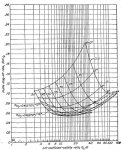Chuck,
I do recall reading in other various publications and papers that Cierva did settle on the maximum blade loading of 35 lb/sq ft, however I don't recall Cierva settling on a solidity ratio of no less than 0.035 that is commonly espoused by modern gyroplane designers.
In Martin Hollmann's book, FLYING THE GYROPLANE, he reports the following:
Cierva C30
Empty Weight - 1,261 lb
Gross Weight - 1.900 lb
Rotor Diameter - 37 ft
Blade Cord - 11 in
Number of Blades - 3
Solidity Ratio - 0.047
(Blade Load - 37.346 lb/sq ft)
Fa 330
Empty Weight - 180 lb
Gross Weight - 420 lb
Rotor Diameter - 24 ft
(Blade Cord - 11.988 in)
Disk Load - 0.73 lb/sq ft
Number of Blades - 3
solidity Ratio - 0.0795
(Blade Load - 35.964 lb/sq ft)
Hafner Rotachute
Empty Weight - 90 lb
Gross Weight - 290 lb
Rotor Diameter - 15 ft
Blade Cord - 8 in
Number of Blades - 2
Disc Load - 1.64 lb/sq ft
Solidity Ratio - 0.0565
(Blade Load - 28 lb/sq ft)
Bensen B-8M
Empty Weight - 247 lb
Gross Weight - 500 lb
Rotor Diameter - 20 ft
Blade Cord - 7 in
Number of Blades - 2
Solidity Ratio - 0.037
(Blade Load 20 ft dia rotor - 42.856 lb/sq ft)
(Blade Load 23 ft dia rotor - 37.267 lb/sq ft)
HA-2M Sportster
Empty Weight - 630 lb
Gross Weight - 1,100 lb
Rotor Diameter - 28 ft
Blade Cord - 9 in
Number of Blades - 2
Disc Load - 1.79 lb/sq ft
Solidity Ratio - 0.034
(Blade Load - 52.381 lb/sq ft)
McCulloch J2
Empty Weight - 1,000 lb
Gross Weight - 1,500 lb
Rotor Diameter - 26 ft
Blade Cord - 6.74 in
Number of Blades - 3
Disk Load - 2.82 lb/sq ft
Solidity Ratio - 0.0413
(Blade Load - 68.478 lb/sq ft)
Air & Space 18A
Empty Weight - 1,315 lb
Gross Weight - 1,800 lb
Rotor Diameter - 35 ft
Blade Cord - 12.5 in
Number of Blades - 3
Disk Load - 1.87 lb/sq ft
Solidity Ratio - 0.057
(Blade Load - 32.914 lb/sq ft)
Granted, Hollmann had a history of some inaccuracies in his figures, however I think the above list is within the "ballpark" of actual measurements. The blade load measurements in parentheses are based on the above figures and were not provided by Hollmann.
There is merit in using a three blade, fully articulating rotor system with larger and heavier gyroplanes, however we all know that more complexity means more cost.
The reality is we're basically stuck with the relativity inexpensive, 2 blade, semi-rigid, teetering, rotor system, especially if we want a gyroplane to fit within the current Sport Pilot regulations. As a result, we inevitably give up the maximum recommended blade loading of 35 lb/sq ft.
Chuck, I personally would like to see a simple three blade rotor system based on your original design on a number of two place gyroplanes now in existence. Think of the performance gain as a result!
Wayne



